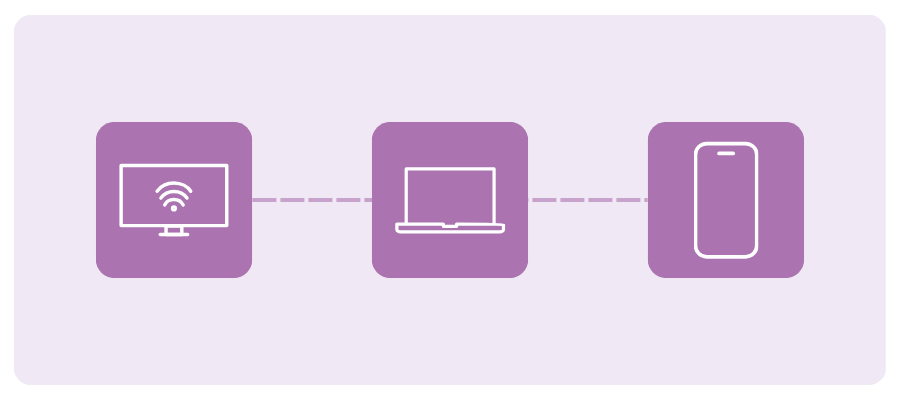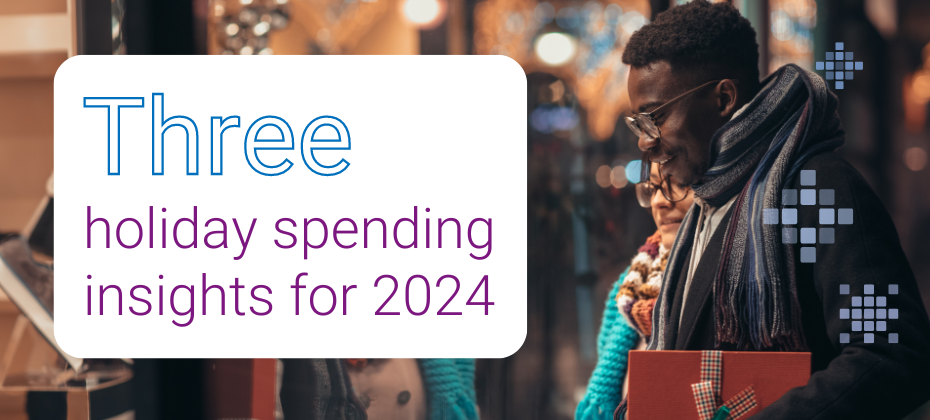At A Glance
Infillion and Experian collaborate to help advertisers connect with audiences across devices and channels, as cookies and mobile identifiers disappear. By integrating Experian's Digital Graph and Offline Identity Resolution, Infillion strengthens identity connections, improves campaign reach, and enhances audience engagement across CTV, mobile, and web.In our Ask the Expert Series, we interview leaders from our partner organizations who are helping lead their brands to new heights in AdTech. Today’s interview is with Ben Smith, VP of Product, Data Products at Infillion.
Adapting to signal loss
What does the Experian–Infillion integration mean for advertisers looking to reach audiences as signals fade?

As cookies and mobile identifiers disappear, brands need a new way to find and reach their audiences. The Experian integration strengthens Infillion’s XGraph, a cookieless, interoperable identity graph that supports all major ID frameworks, unifying people and households across devices with privacy compliance, by providing a stronger identity foundation with household- and person-level data. This allows us to connect the dots deterministically and compliantly across devices and channels, including connected TV (CTV). The result is better match rates on your first-party data, more scalable reach in cookieless environments, and more effective frequency management across every screen.
Connecting audiences across channels
How does Experian’s Digital Graph strengthen Infillion’s ability to deliver addressable media across channels like CTV and mobile?

Experian strengthens the household spine of XGraph, which means we can accurately connect CTV impressions to the people and devices in that home – then extend those connections to mobile and web. This lets us plan, activate, and measure campaigns at the right level: household for CTV, and person or device for mobile and web. The outcome is smarter reach, less waste from over-frequency, and campaigns that truly work together across channels.
The value of earned attention
Infillion has long championed “guaranteed attention” in advertising. How does that philosophy translate into measurable outcomes for brands?

Our engagement formats, such as TrueX, are based on a simple principle: attention should be earned, not forced. Viewers choose to engage with the ad and complete an action, which means every impression represents real, voluntary attention rather than passive exposure. Because of that, we consistently see stronger completion rates, deeper engagement, and clearer downstream results – like lower acquisition costs, improved on-site behavior, and measurable brand lift.
To take that a step further, we measure attention through UpLift, our real-time brand lift tool. UpLift helps quantify how exposure to a campaign influences awareness, consideration, or purchase intent, providing a more complete picture of how earned attention translates into business impact.
Creative innovation and location insights
Beyond identity resolution, what are some of Infillion’s capabilities, like advanced creative formats or location-based insights, that set you apart in the market?

One key area is location intelligence, which combines privacy-safe geospatial insights with location-based targeting through our proprietary geofencing technology. This allows us to build custom, data-driven campaigns that connect media exposure to real-world outcomes – like store visits and dwell time – measured through Arrival, our in-house footfall attribution product.
We also build custom audiences using a mix of zero-party survey data, first-party location-based segments, and bespoke audience builds aligned to each advertiser’s specific strategy.
Then there’s creative innovation, which is a major differentiator for us. Our high-impact formats go beyond static display, such as interactive video units that let viewers explore products through hotspots or carousels, rich-media ads that feature polls, quizzes, dynamic distance, or gamified elements, and immersive experiences that encourage active participation rather than passive viewing. These creative formats not only capture attention but also generate deeper engagement and stronger performance for a variety of KPIs.
Future ready media strategies
How does Infillion’s ID-agnostic approach help brands future-proof their media strategies amid ongoing privacy and tech changes?

We don’t put all our eggs in one basket. XGraph securely unifies multiple durable identifiers alongside our proprietary TrueX supply to strengthen CTV household reach. This agnostic design allows us to adapt as platforms, regulations, and browsers evolve – so you can preserve reach and measurement capabilities without getting locked into a single ID or losing coverage when the next signal deprecates.
Raising the bar for media accountability
Looking ahead, how is Infillion evolving its platform to meet the next wave of challenges in audience engagement and media accountability?
From an engagement standpoint, we’re expanding our ability to support the full customer journey, offering ad experiences that move seamlessly from awareness to consideration to conversion. That includes smarter creative that adapts to context, intelligent targeting and retargeting informed by real data, and formats designed to drive measurable outcomes rather than just impressions.
When it comes to accountability, we’re ensuring that measurement is both flexible and credible. In addition to our proprietary tools, we partner with leading third-party measurement providers to validate results and give advertisers confidence that their investment is truly performing. Within our DSP, we emphasize full transparency and log-level data access, ensuring advertisers can see exactly what’s happening on every impression.
All of this builds toward the next era of agentic media buying – one enabled by our MCP suite and modular, component-based tools. This evolution brings greater accountability and next-generation audience engagement to an increasingly automated, intelligent media landscape. Our goal is to help brands connect more meaningfully with audiences while holding every impression – and every outcome – to a higher standard of transparency and effectiveness.
Driving impact across the funnel
What is a success story or use cases that demonstrate the impact of the Experian–Infillion integration?
We recently partnered with a national veterans’ organization to raise awareness of its programs for injured or ill veterans and their families. Using the Experian integration, we combined persistent household- and person-level identifiers with cross-device activation to reach veteran and donor audiences more precisely across CTV, display, and rich media. The campaign achieved standout results – industry-leading engagement rates, a 99% video completion rate, and measurable lifts in both brand awareness (3.6 % increase) and donation consideration (13.7% lift). It’s a clear example of how stronger identity and smarter activation can drive meaningful outcomes across the full funnel.

Contact us
FAQs
Identity resolution ensures accurate connections between devices, households, and individuals. Experian’s Offline Identity Resolution and Digital Graph strengthen these connections for improved targeting and consistent measurement across CTV, mobile, and web.
Solutions like Experian’s Digital Graph enable brands to connect first-party data to household and person-level identifiers, ensuring scalable reach and compliant audience targeting legacy signals fade.
Focusing on earned attention (where audiences actively choose to engage) leads to stronger completion rates, improves on-site behavior, and drives measurable increases in brand awareness and consideration.
By linking CTV impressions to households and extending those connections to mobile and web, Experian’s identity solutions ensure campaigns work together seamlessly, reducing over-frequency and improving overall reach.
About our expert

Ben Smith, VP Product, Data Products
Ben Smith leads Infillion’s Data Products organization, delivering identity, audience, and measurement solutions across the platform. Previously, he was CEO and co-founder of Fysical, a location intelligence startup acquired by Infillion in 2019.
About Infillion

Infillion is the first fully composable advertising platform, built to solve the challenges of complexity, fragmentation, and opacity in the digital media ecosystem. With MediaMath at its core, Infillion’s modular approach enables advertisers to seamlessly integrate or independently deploy key components—including demand, data, creative, and supply. This flexibility allows brands, agencies, commerce and retail media networks, and resellers to create tailored, high-performance solutions without the constraints of traditional, all-or-nothing legacy systems.
Latest posts

With over one billion shoppers eagerly preparing to shop for gifts, decorations, and seasonal essentials, now is the perfect time to refine your marketing tactics and connect with these shoppers. With holiday retail sales set to reach $1.37 trillion, it’s time to unwrap holiday spending insights to ensure that your holiday advertising campaigns light up the festive season. The holiday shopping frenzy offers marketers and retailers a chance to capture attention, drive sales, and build lasting customer relationships. In this blog post, we’ll reveal holiday shopping audiences, including 19 new audiences, designed for you to reach the most relevant shoppers for your campaigns. These audiences are available for activation on-the-shelf of most major ad platforms, including TV and programmatic. You can find the complete audience segment name in the appendix. 2025 Holiday spending trends and insights report Download our latest report for data-driven insights you can use to refine your messaging and reach the right audience in their preferred channels this holiday season. Download now What separates Experian's syndicated audiences Experian’s 2,400+ syndicated audiences are available directly on over 30 leading television, social, programmatic advertising platforms, and directly within Audigent for activation within private marketplaces (PMPs). Reach consumers based on who they are, where they live, and their household makeup. Experian ranked #1 in accuracy by Truthset for key demographic attributes. Access to unique audiences through Experian’s Partner Audiences available on Experian’s data marketplace, within Audigent for activation in PMPs and directly on platforms like DirectTV, Dish, Magnite, OpenAP, and The Trade Desk. Download our 2024 holiday shopping report Holiday shopping styles It's important to understand how your holiday shopper “shops,” with individual shopping styles varying from a last-minute dash to the store to the one-stop shopper. One in three consumers anticipate beginning their holiday shopping before October this year, with Millennials and Gen Xers being the most proactive, due to concerns about items running out of stock. In contrast, 42% of Boomers are generally less inclined to shop early, wanting to start their holiday shopping in November or December. All generations are motivated to shop early by discounts.1 By choosing and activating the right audience segments, you can deliver messages that resonate with the consumer's preferred shopping style, ensuring your holiday campaign will align with their shopping preferences and behaviors. Here are five audiences that you can activate based on shopping style: Last-Minute Holiday Shoppers One Stop Holiday Shoppers/Power Shoppers: In-Store or Online Impulse Buyers eCommerce Diehards Brick & Mortar Diehards Discount-seeking shoppers The holiday season is a time of giving, but also saving! Consumers are driven to shop early by discounts and early sales — 52% of consumers said discounts are their biggest motivator to shop early. Price is another crucial factor — 47% of consumers said price is the most important factor when deciding where to shop during the holiday season. Major holiday shopping events, such as Thanksgiving Day, Black Friday, and Cyber Monday, are expected to attract a significant portion of consumers this upcoming year.2 Here are eight audiences you can activate to reach discount-seeking shoppers: NEW! Discount Holiday Shoppers NEW! Cyber Monday Holiday Shoppers NEW! Black Friday Holiday Shoppers NEW! Big Box/Club Stores Holiday Shoppers NEW! Online Coupon Users TrueTouch: Online Coupon Site Department Store Deal Shoppers: In-Store or Online Post Holiday Shoppers Gift givers Holiday shoppers are torn between saving and splurging. Nearly a third of consumers anticipate spending more on holiday shopping this year, while the same number of consumers say they’ll be spending less. Boomers anticipate spending the most on gift cards, Gen Z on clothing, and Millennials on toys, electronics, and experiences.3 Given holiday shoppers' varied spending habits, it's important to target the right audience segments to maximize your impact. Targeting specific audience segments allows advertisers to better reach those most interested in their products. Here are six audiences you can activate to target gift givers: NEW! Luxury Gift Shoppers NEW! Holiday Shopping High Spenders NEW! Holiday Shopping Moderate Spenders NEW! Holiday Charitable Donations High Spend Gift Shoppers Heavy Buyer/Spenders Holiday Shoppers: In-Store or Online Holiday travelers In 2023, nearly three million travelers passed through airports on the Sunday after Thanksgiving alone. Take advantage of the busy travel season with our audience segments. By targeting specific travel preferences and behaviors, you can capture the attention of individuals planning trips this holiday season. Here are seven audiences to tailor your campaign according to travel preferences: NEW! Holiday International Travelers NEW! Holiday Travel-Train NEW! Holiday Budget Savvy Airline Travelers Vacation/Leisure Travelers: Domestic Trips Air Travel (FLA/Fair Lending Friendly)4 Vacation/Leisure Travelers: Frequent Spenders Hotels: Frequent Spend When you work with Experian, you work with a single data provider that gives you access to audiences across multiple verticals and categories, such as travel and retail. Targeted advertising this holiday season with Experian audiences The holiday season is the busiest time of the year for advertisers. Experian's data, ranked #1 in accuracy by Truthset, allows advertisers to reach people based on demographic, geographic, and behavioral attributes (e.g. websites visited and purchase history). By using Experian’s audiences in your holiday advertising campaigns, you can reach last-minute shoppers, discount-seeking shoppers, gift-givers, and holiday travelers. Just as shoppers seek the perfect gifts, with the right strategy, your holiday advertising campaigns can capture the right shoppers this holiday season. Need a custom audience? Reach out to our audience team and we can help you build and activate an Experian audience on the platform of your choice. Additionally, work with Experian’s network of data providers to build audiences and send to an Audigent PMP for activation. Connect with our audience team You can activate our syndicated audiences on-the-shelf of most major platforms. For a full list of Experian’s syndicated audiences and activation destinations, download our syndicated audiences guide. Explore our other seasonal audiences that you can activate today. View now Download our 2025 Holiday spending trends and insights report This holiday season is about more than just transactions – it’s about cultivating meaningful connections with your audience. Download our 2025 Holiday spending trends and insights report, in collaboration with GroundTruth, to access all of our predictions for this year’s holiday season. Download now Contact us Footnotes Online survey conducted in June, 2024 among n=1,000 U.S. adults 18+. Sample balanced to look like the general population on key demographics (age, gender, household income, ethnicity, and region). n = 204 Gen Z, n = 234 Millennials, n = 270 Gen X, n = 272 Baby Boomers. Online survey. Online survey. “Fair Lending Friendly” indicates data fields that Experian has made available without use of certain demographic attributes that may increase the likelihood of discriminatory practices prohibited by the Fair Housing Act (“FHA”) and Equal Credit Opportunity Act (“ECOA”). These excluded attributes include, but may not be limited to, race, color, religion, national origin, sex, marital status, age, disability, handicap, family status, ancestry, sexual orientation, unfavorable military discharge, and gender. Experian’s provision of Fair Lending Friendly indicators does not constitute legal advice or otherwise assures your compliance with the FHA, ECOA, or any other applicable laws. Clients should seek legal advice with respect to your use of data in connection with lending decisions or application and compliance with applicable laws. Appendix Here are the complete audience segment names (taxonomy paths) for all audience segments discussed in this blog post. Holiday shopping styles Retail Shoppers: Purchase Based > Seasonal > Holiday Shoppers: Last-Minute Holiday Shoppers Retail Shoppers: Purchased Based > Seasonal > Holiday Shoppers: One Stop Holiday Shoppers/Power Shoppers: In-Store Retail Shoppers: Purchased Based > Seasonal > Holiday Shoppers: One Stop Holiday Shoppers/Power Shoppers: Online TrueTouch: Communication Preferences > Purchase Behavior > Impulse buyers Retail Shoppers: Purchase behavior > Shopping Behavior > In-Store vs. Online: eCommerce Diehards Retail Shoppers: Purchase behavior > Shopping Behavior > In-Store vs. Online: Brick & Mortar Diehards Discount-seeking shoppers NEW! Retail Shoppers: Purchase Based > Seasonal > Holiday Shoppers: Cyber Monday NEW! Retail Shoppers: Purchase Based > Seasonal > Holiday Shoppers: Black Friday NEW! Retail Shopper: Purchase Based > Seasonal > Holiday Shoppers: Big Box/Club Stores Shoppers NEW! Retail Shoppers: Purchase Based >> Discount Holiday Shoppers NEW! Retail Shoppers: Purchased Based > Shopping Behavior > Online Coupon Users TrueTouch: Communication Preferences> Purchase Behavior > Online Coupon Site Retail Shoppers: Purchased Based > Shopping Behavior > Department Store Deal Shoppers Online Spenders Retail Shoppers: Purchased Based > Shopping Behavior > Department Store Deal Shoppers In-Store Spenders Retail Shoppers: Purchased Based > Seasonal > Holiday Shoppers: Post holiday Gift givers NEW! Retail Shoppers: Purchase Based > Seasonal > Holiday Shoppers: Luxury Gift Shoppers NEW! Retail Shoppers: Purchase Based > Seasonal > Holiday Shoppers: High Spenders NEW! Retail Shoppers: Purchase Based > Seasonal > Holiday Shoppers: Moderate Spenders NEW! Retail Shoppers: Purchase Based > Seasonal > Holiday Charitable Donations Retail Shoppers: Purchase Based > Shopping Behavior > Gift Shoppers High Spend Spenders Retail Shoppers: Purchase Based > Seasonal > Holiday Shoppers: Heavy Buyer/Spenders: Online Retail Shoppers: Purchase Based > Seasonal > Holiday Shoppers: Heavy Buyer/Spenders: In Store Holiday travelers NEW! Retail Shoppers: Purchase Based > Seasonal > Holiday International Travelers NEW! Retail Shoppers: Purchase Based > Seasonal> Holiday Travel-Train NEW! Retail Shoppers: Purchase Based > Seasonal > Holiday Budget Savvy Airline Travelers Retail Shoppers: Purchase Based > Travel > Vacation/Leisure Travelers: Domestic Trips Lifestyle and Interests (Affinity) > Travelers > Air Travel (FLA/Fair Lending Friendly) Retail Shoppers: Purchase Based > Travel > Vacation/Leisure Travelers: Frequent Spenders Retail Shoppers: Purchase Based > Travel > Hotels: Frequent Spend Latest posts

In our Ask the Expert Series, we interview leaders from our partner organizations who are helping to lead their brands to new heights in ad tech. Today’s interview is with Jordan Feivelson, VP, Digital Audiences at Webbula. Jordan is a 22-year advertising industry veteran who has worked for media properties such as WebMD and Disney. Over the past ten years, he has transitioned to the data and programmatic space, including growing the data business for Kantar Shopcom and Adstra. What types of advertisers might benefit from utilizing Webbula audiences across various verticals? Can you provide examples of how different industries successfully leverage your data to achieve specific campaign goals? Most advertisers can leverage Webbula’s award-winning attributes for their activation initiatives. Webbula offers approximately 3,000 syndicated segments covering categories such as Demographics, Automotive, Political, Mortgage, B2B, Hobby/Interest/Lifestyle, and Interests & Brand Preferences (brand name targeting). Audience insights and marketing strategies What specific types of audience segments does Webbula provide? How can advertisers leverage these segments to craft more effective, personalized marketing strategies? Webbula has incredible depth and breadth within its verticals, giving marketers the tools to deliver targeted messaging effectively. Our Demographic, B2B, Mortgage, Automotive, and Interest and Brand Preferences segments each contain 500-1,000 segments, all built on deterministic, self-reported, and individually linked data. We ensure the best accuracy with multiple deterministic data points tied to the real world (ex., first name, last name, postal address, and email address). Some examples of our unique syndicated audience types: B2B: A view of the latest industry trends with detailed cuts of the professional world, such as companies with and not within the Fortune 500 companies and job positions that are directors and below. This also includes custom capabilities, including ABM (list of target companies in an activation campaign or by industry code (ex. NAICS, SIC). Interest and Brand Preferences: Consumers who have shown interest and affinity to hundreds of brands (ex., Nike), genres (ex., comedy, hip hop), sports teams, and more. Mortgage: A detailed view of homebuyers’ purchase range, loan type (ex. jumbo loan, standard loan), mortgage amount, interest rate, and more. With Webbula’s audience data, brands can create a comprehensive picture of their audiences down to the individual level and reach them accurately. Data quality, sourcing, and differentiation How is consumer data sourced and curated at Webbula? Are there data quality standards that Webbula establishes for consumer data, and how do you ensure your sources and methods meet these standards consistently? Webbula’s data is aggregated from over 110 trusted and authenticated sources, including publishers, data partners, social media, and more. The data collected comes directly from consumers who self-report information through surveys and other methods. We apply our hygiene filters to mitigate fraud and accurately score the data. Data Collection: The data collected comes directly from consumers who self-report information through surveys, questionnaires, transactions, and sign-ups. This ensures that brands display ads to audiences based on self-identified, cross-channel behaviors, not modeled assumptions. Hygiene Solutions: Webbula applies multi-method hygiene solutions to mitigate fraud and accurately score the data before onboarding, ensuring that all data meets the highest quality standards. Examples of Data Sources: Questionnaires: Self-reported data through surveys, offer submissions, and telemarketing. Transactions: Deterministic data from aftermarket parts, online purchases or services, and more. Sign-ups: Individually linked data from information entered through sweepstakes, infomercials, newsletters, and forms. What differentiates Webbula's data from other data providers in the market? Can you explain the unique value proposition that Webbula offers in terms of data depth and breadth? Due to our extensive experience in data cleansing, we provide the most accurate data within the programmatic ecosystem. TruthSet, the leading programmatic accuracy measurement company, has ranked Webbula as having the highest number of top attributes compared to other data providers with 150M+ HEMs. Additionally, Publicis Groupe and Neutronian further validate Webbula's data quality, underscoring its position as a leader in the industry. Webbula's data stands out in the market due to its unmatched accuracy and quality, achieved through years of expertise in data cleansing. Unlike other providers, Webbula’s foundation lies in its robust email hygiene process, ensuring that all data entering the programmatic ecosystem is thoroughly cleansed. Privacy, compliance, and future-proofing What measures does Webbula take to maintain data privacy and compliance? How do these efforts benefit advertisers in an evolving regulatory landscape and ensure ethical standards? Webbula was created over a decade ago with a future-proof, privacy-compliant foundation. We understand the industry’s rapid changes, including government and state legislation and cookie depreciation. Our goal has always been to build long-term partnerships and ensure we are prepared for industry changes. We rely on validated offline data sources, making us resilient to external influences. Success stories Can you share success stories where advertisers saw significant campaign improvements using Webbula’s data? What were the key factors that contributed to these successes? Our success is measured by client feedback and increased client spend. Webbula has helped several key advertisers achieve six-figure monthly thresholds by providing the most accurate data to meet campaign KPIs. Clients consistently return to use our data, validating our belief that “the proof is in the pudding.” Thanks for the interview. Any recommendations for our readers if they want to learn more? For those interested in learning more about Webbula, reach out for a personalized consultation. Contact us Latest posts

This holiday shopping season, marketers will look to take advantage of the surge in spending across channels like connected TV (CTV), programmatic, and mobile. Despite challenges such as privacy regulations and Google's new cookie deprecation plan, this moment presents a unique opportunity for marketers to reshape their traditional approaches to consumer engagement and capitalize on these changes. As we approach the holiday season, understanding how consumers spend, where they shop, and how their shopping habits are changing are key components to consider when crafting your holiday advertising campaigns. Our 2024 Holiday spending trends and insights report utilizes our expertise in data and insights to highlight emerging consumer behaviors and spending patterns. In our report, we share what these trends mean for marketers and how Experian can help, so you can refine your messaging and target the right audience through the best channels. Download our 2024 report In this blog post, we cover three insights from our report. Watch our video for a recap below. 1. Consumers are shopping evenly throughout the holiday season 35% of holiday shopping was done in December, peaking at 9% of total holiday sales the week before Christmas. Cyber Week, the five-day period between Thanksgiving and Cyber Monday, and the week before Christmas brought the highest weekly sales for the past two holiday seasons. What this means for marketers Prepare for an extended promotional period. Schedule your marketing campaigns and sales initiatives to maximize impact during the extended season, focusing on the peaks of Cyber Week and the week before Christmas. How Experian can help you target these shoppers Experian's data, ranked #1 in accuracy by Truthset, offers advertisers the ability to reach people based on demographic, geographic, and behavioral attributes (e.g. websites visited and purchase history). Our audiences are available on-the-shelf of most major platforms, making it easy for you to activate and target holiday shoppers. We recently released 19 new holiday-focused audience segments. Here are a few you can activate: Black Friday Shoppers Cyber Monday Shoppers Big Box/Club Store Shoppers Luxury Gift Shoppers Discount Holiday Shoppers Holiday Airline Travel 2. Online shopping is leveling out Online holiday spending continues to remain around a third of all holiday shopping spending. We are starting to see online shopping slow and level out – people are going back in-store. The high amount of online shopping we saw during the pandemic is starting to return to pre-pandemic behaviors. Consumers are spending more in-store at department and discount stores but are shopping online for office/electronics/games, mass retailers, and apparel. 84% of holiday shopping was done in-store for discount stores. 79% of holiday shopping was done in-store for department stores. 64% of holiday shopping was done online for office, electronics, and games stores. What this means for marketers Digital and physical experiences work together. Retailers should have a multi-channel plan to reach consumers, tailoring their approach to their target audience and product and creating engaging in-store experiences to drive visitors. How Experian can help you target and measure across channels We connect online and offline data to enable precise targeting and measurement of marketing efforts across multiple channels. Read our case study with Cuebiq to learn how they used our Activity Feed solution to deliver in-store lift analyses to their clients. 3. CTV is the top channel to reach consumers Over two-thirds of the U.S. population now use CTV, and the average time spent among adults is expected to surpass two hours per day in 2024. CTV offers a creative ad experience similar to its linear counterpart but provides more sophisticated targeting and analytics capabilities. What this means for marketers As CTV viewing continues to dominate, the importance of cross-device targeting and measurement increases. How Experian can help you reach shoppers across devices Later this year, we’ll add support for IPv6 in our Digital Graph as well as phone-based UID2s. This is in addition to our current coverage of IPv4 and email-based UID2s. As a result, all IP signals and UID2s will be resolved back to Experian’s household and individual profiles and their associated devices, which means marketers and platforms can better understand the full customer journey and reach people across their devices. Download our 2025 Holiday spending trends and insights report This holiday season is about more than just transactions – it’s about cultivating meaningful connections with your audience. Download our 2025 Holiday spending trends and insights report, in collaboration with GroundTruth, to access all of our predictions for this year's holiday season. Download now When you work with Experian for your holiday shopping campaigns, you're getting: Accurate consumer insights: Better understand your customers' behavioral and demographic attributes with our #1 ranked data covering the full U.S. population. Signal-agnostic identity solutions: Our deep understanding of people in the offline and digital worlds provides you a persistent linkage of personally identifiable information (PII) data and digital IDs, ensuring you accurate cross-device targeting, addressability and measurement. Secure connectivity: Bring data and identity to life in a way that meets your needs by securely sharing data between partners, utilizing the integrations we have across the ecosystem, and using our marketing data in flexible ways. Make the most of this holiday shopping season with Experian. Contact us today to get started. Contact us Latest posts